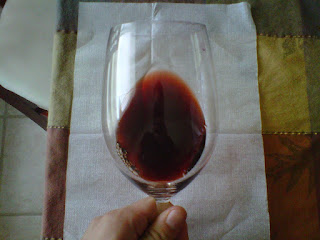Hi everybody, the weekend is upon us, and so is some questionable weather in Northern California. Sorry wine grapes, maybe its just not your year. I will say that there will be a Buyer Beware in the market if the vintage turns out to be moderate. We already know the crop is going to be very small, so volume is low and the good bottlings will be ultra expensive in California. $100 plus for Napa/Sonoma Cabs and Sonoma Pinots will not shock me at all. With that said, take advantage of all the deals in the market because all the surplus stock will be getting smaller everyday.
Well I thought for today we would keep the theme going I started last week, and do another lesson installment. Did anyone get a chance to do lasts weeks experiment focusing on mouthfeels in differnet wines? I hope so because it is a key element in analyzing the types of wines you will ultimately like. For lesson 2 I thought it would be good to start at the beginning, looking at a wine like a detective, well maybe not that investigative. In general though, one can get a lot of clues about a wine by just looking at it. I am in the position of blind tasting wines a lot, and I often use these principals to decipher what I am tasting.
For this lesson I do not expect people to be blind tasting, although it is a very fun activity to do in a small group format. I will note at times why certain things are important with respect to blind tasting.
Ok to begin: Make sure you have a clean White backdrop and simply grab some wine and pour it into your glass, any wine that you enjoy will do. Before beginning I must make this very important note: DO NOT SWIRL THE GLASS! Sounds crazy right? Everyone says you should swirl the glass a bunch to "wake up the aromas" of the wine. Well thats right, but we are NOT smelling the wine, just looking at it. We do not want to swirl because some wines have trapped carbon dioxide (CO2) and swirling the glass will break all this up.
What I like to do is grab the stem of the glass and roll the wine around in the glass, allowing the wine to coat the glass. I note the Brigthness of the wine first, then the 3 C's-Color,Clarity,Concentration. To generalize, a more youthful wine will have more brightness to it, and the 3 C's can be affected by both the varietal(s) as well as the winemakers choices along the way.
Look at the wine in the glass from a couple different angles, tilt the glass towards you, then away from you, look straight down at it. These acts will help tell you what kind of wine you are drinking by knowing grape qualities. For example Pinot Noir will generally be much lighter in color and concentration than Syrah. Knowing this would tell you better what you are drinking in a blind format.
Notice if there is and sediment in the glass? How about any trapped gas bubbles? Sediment is a good clue because it could tell you the style of the winemaker (nonfiltered/nonfined) and more importantly the age of the wine. The older the wine, especially red wines, the more sediment will naturally be thrown. The concentration of wines will fade out as it gets closer to the rim, and this rim variation can tell us a lot about age as well. The larger the rim variation (which looks like a water ring around the edge of the wine) the older the wine.
Lastly when looking at a wine check out what we call viscosity. The amount of friction created between the wine and the glass, in lehmans terms this is called the legs of the wine. In red you will want to look at these legs for staining. The thicker the skin of the grape the darker the stain of the tears. We can also get a clue about alcohol here. the higher the alcohol level the more the wine will coat the glass, giving the appearance of a more oily thick looking legs on the glass.
Use the same 4 wines as from lesson 1 and do both lessons together if you have not had a chance. I think it is very important to be properly educated to taste in the right way, but remember to have fun with it. For a reference when I am blindtasting in a timed format, I try not to spend more than 30 seconds on this portion of analysis. Have fun! Salute!

No comments:
Post a Comment